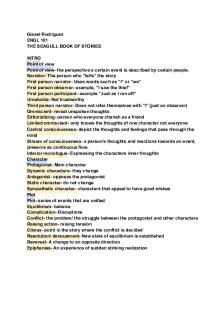Salman Rushdie’s Haroun and the Sea of Stories: Epitomising the Use of Stories that Aren’t Even True DOCX

| Title | Salman Rushdie’s Haroun and the Sea of Stories: Epitomising the Use of Stories that Aren’t Even True |
|---|---|
| Author | A. van der Woude |
| Pages | 8 |
| File Size | 150.3 KB |
| File Type | DOCX |
| Total Downloads | 12 |
| Total Views | 163 |
Summary
In Rushdie’s Haroun and the Sea of Stories, Tales of Times and Cultures Afar Epitomize the Transcendent Use of Stories that Aren’t True After having published novels for an adult audience, in 1990 Sir Salman Rushdie published his first children’s book, Haroun and the Sea of Stories1. This colourful,...
Description
In Rushdie's Haroun and the Sea of Stories, Tales of Times and Cultures Afar Epitomize the Transcendent Use of Stories that Aren't True After having published novels for an adult audience, in 1990 Sir Salman Rushdie published his first children's book, Haroun and the Sea of Stories1 . This colourful, humoristic and alliterating written tale uses a metanarrative to describe the adventure of its twelve-year old protagonist, Haroun Khalifa in his quest in a transcendental realm. It bears many literary gifts that might, perhaps, remain unseen by a younger audience yet are noticeable and therefore increase its integrity, for adult readers when read on a deeper level. Critics and reviewers of Haroun and the Sea of Stories tend to agree that this novel has been Rushdie's response to his personal situation as it was the first work he published after he had been forced into hiding due to a fatwa announced by the Ayatollah Khomeini of Iran whom hereby sentenced him to death. While to a certain extent this novel can irrefutably be read as such an allegory, there is a level of ambiguity in assessing the novel to merely be a reading of the tribulations Rushdie hereby encountered. The novel offers food for thought relating to deeper moral issues than the interpretation of solemnly relating to freedom of speech and literature, as deeper allegorical surfaces relating to borders and languages, as well as political and cultural conflicts afloat, when read on a deeper level. This essay will discuss how Rushdie juxtaposes literary sources and traditions from both Eastern and Western cultures as well as various era's, and makes its moral internationally relatable in providing an answer to the question our protagonist ruminates on: 'What's the use of stories that aren't even true?'2 . Followed by discussing the assumed allegory whilst simultaneously deconstructing, this to finalize by expatiating on colonial issues that can be interpreted from this tale's abundant level of allusion. By making use of numerous literary traditions and sources derived from both Western and Eastern history and legacies that are being juxtaposed among one another, as well as with more modern influences, Rushdie creates a 1 Salman Rushdie, Haroun and the Sea of Stories (London: Granta, 1991) [All other references to the text are taken from this edition] 2 S. Rushdie, p.22...
Similar Free PDFs

Haroun and The Sea of Stories
- 1 Pages

Haroun and the Sea of Stories
- 3 Pages

THE Seagull BOOK OF Stories
- 7 Pages

The truth about stories.
- 5 Pages

Eng112W The Truth about Stories
- 5 Pages

Week 6 - Task - Types of stories
- 4 Pages
Popular Institutions
- Tinajero National High School - Annex
- Politeknik Caltex Riau
- Yokohama City University
- SGT University
- University of Al-Qadisiyah
- Divine Word College of Vigan
- Techniek College Rotterdam
- Universidade de Santiago
- Universiti Teknologi MARA Cawangan Johor Kampus Pasir Gudang
- Poltekkes Kemenkes Yogyakarta
- Baguio City National High School
- Colegio san marcos
- preparatoria uno
- Centro de Bachillerato Tecnológico Industrial y de Servicios No. 107
- Dalian Maritime University
- Quang Trung Secondary School
- Colegio Tecnológico en Informática
- Corporación Regional de Educación Superior
- Grupo CEDVA
- Dar Al Uloom University
- Centro de Estudios Preuniversitarios de la Universidad Nacional de Ingeniería
- 上智大学
- Aakash International School, Nuna Majara
- San Felipe Neri Catholic School
- Kang Chiao International School - New Taipei City
- Misamis Occidental National High School
- Institución Educativa Escuela Normal Juan Ladrilleros
- Kolehiyo ng Pantukan
- Batanes State College
- Instituto Continental
- Sekolah Menengah Kejuruan Kesehatan Kaltara (Tarakan)
- Colegio de La Inmaculada Concepcion - Cebu









